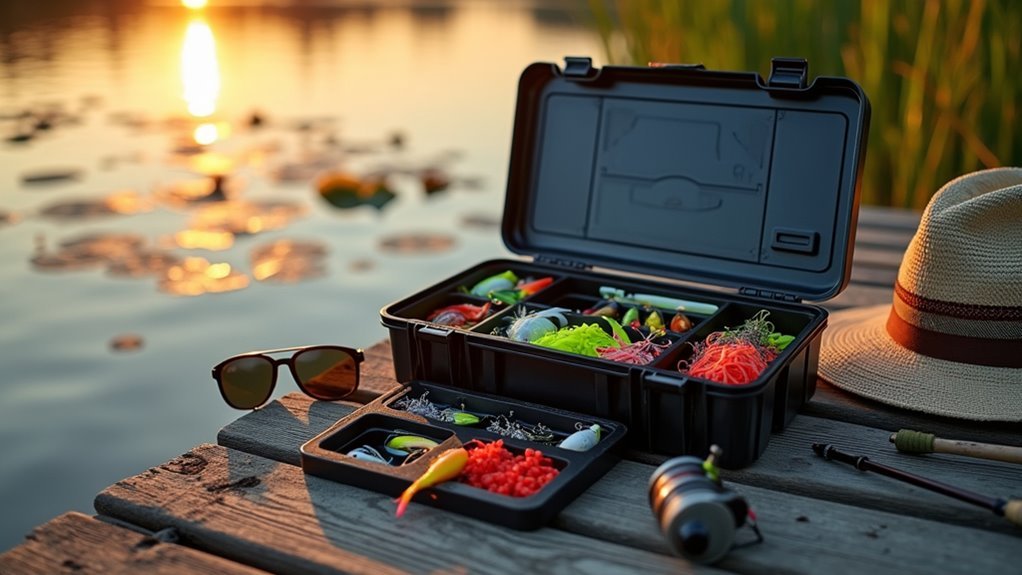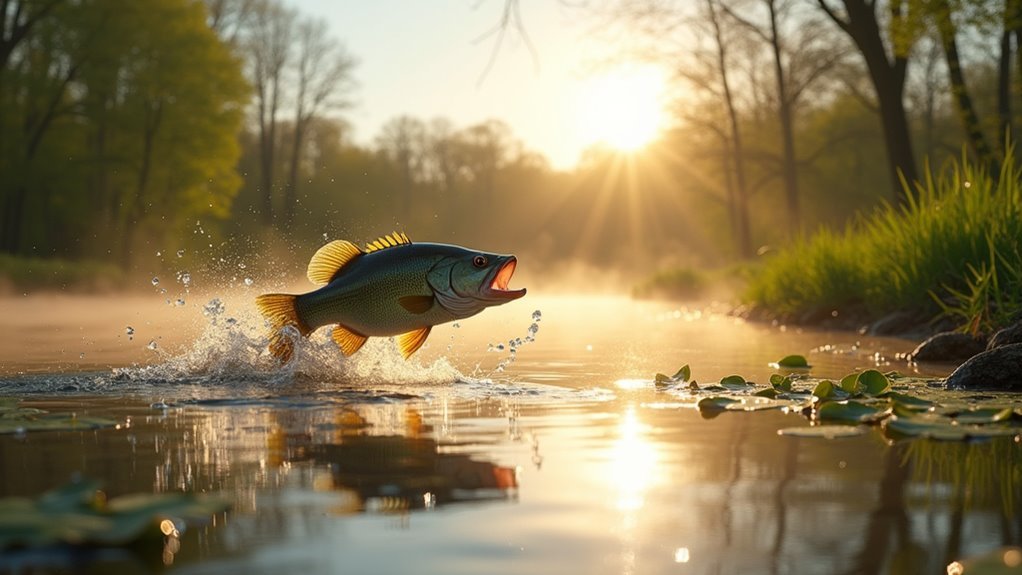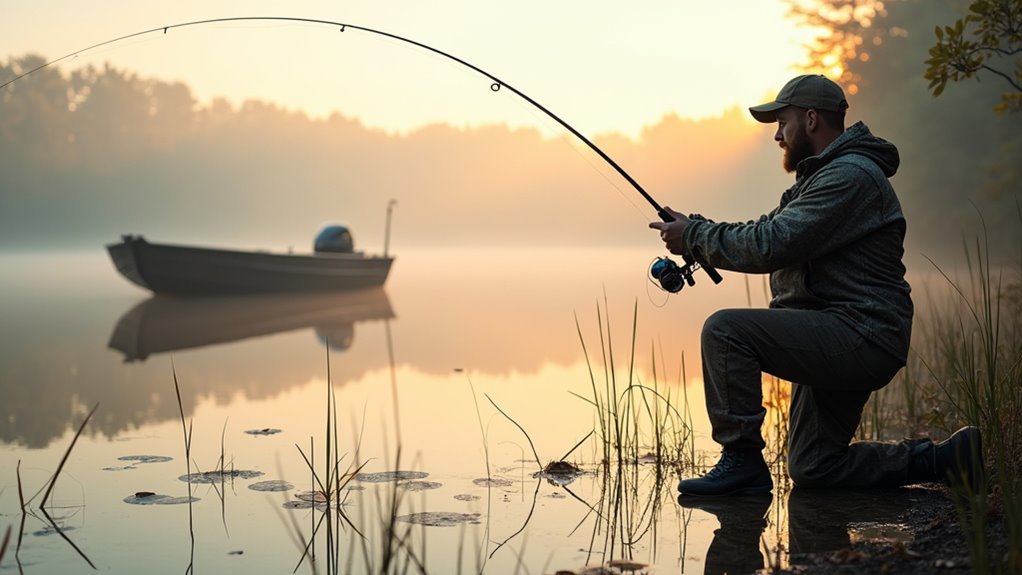We’ve found that mastering pond bass fishing starts with identifying key structures like fallen trees, points, and coves where bass ambush prey. Success depends on matching your gear to seasonal patterns—using Texas-rigged worms in spring, working deeper waters during summer heat, and targeting feeding frenzies in fall. Stay stealthy (bass sense everything!), and approach slowly with neutral colors. Once, we landed a 5-pounder by quietly working a weightless Senko near a submerged log. The secrets await below the surface.
The Science of Finding Bass in Ponds: Mapping High-Percentage Areas

While many anglers cast their lines randomly hoping for a lucky strike, we’ve learned that finding bass in ponds is more science than chance. We look for key structural elements like points, corners, and coves where bass naturally gather to ambush prey.
Last summer, we hit a small farm pond and immediately noticed a fallen tree extending from a point. First cast there? A chunky 4-pounder! Bass love these spots where they can hide while surveying deeper water for food.
Don’t ignore cover—logs, rocks, docks, and vegetation are bass magnets. Before heading out, we often check Google Earth to map potential hotspots, saving valuable fishing time.
Essential Gear for Pond Bass Fishing Success

Success on the pond begins with the right gear in your tackle box. We’ve learned the hard way that being unprepared can turn a promising day into a frustrating one.
For starters, pack a versatile rod-and-reel combo – medium action works wonders in most pond situations. Don’t forget your Texas-rigged worms and weightless Senkos; they’re absolute bass magnets! We once caught a 5-pounder on a purple Senko that still makes us smile.
Include topwater frogs for those scummy areas, chatterbaits for weedy spots, and a few crankbaits for deeper water. A small tackle box keeps everything organized without weighing you down.
Seasonal Patterns: How Weather Affects Bass Behavior in Ponds

Throughout the year, bass behavior shifts dramatically with changing seasons, making today’s hotspot potentially tomorrow’s dead zone. We’ve learned this lesson the hard way!
In spring, bass move to shallow water for spawning, making them visible but protective. Summer drives them deeper seeking cooler temperatures, except during dawn and dusk when they feed near the surface.
Fall triggers feeding frenzies as bass bulk up for winter – they’ll chase fast-moving lures then. Winter slows their metabolism; we’ve caught our biggest pond bass on sunny winter afternoons when they briefly venture into shallow water.
Watch barometric pressure too – falling pressure often sparks pre-storm feeding activity.
Stealth Approaches: Why Quiet Presentations Matter

Because bass have exceptional sensory perception, many anglers ruin their chances before they even cast a line. We’ve learned this lesson the hard way! Bass can feel vibrations through their lateral lines, making your heavy footsteps along the bank a dead giveaway.
Once, I spooked an entire corner of a pond by dropping my tackle box. Remember to approach slowly, wear neutral colors, and keep your shadow off the water. Minimize splashing when casting, and try standing back from the shoreline. Soft entries with weightless baits often outperform noisy lures in pressured ponds.
Top 5 Lure Categories That Consistently Produce Pond Bass

Five essential lure categories have proven themselves time and again on our countless pond fishing adventures. Soft plastics like Texas-rigged worms and Senkos are our go-to for finicky bass. Topwater frogs excel when bass hide under scum mats—we’ve pulled monsters from beneath lily pads! Chatterbaits vibrate through weeds, mimicking injured bluegill perfectly. We’ve had days where crankbaits triggered competitive feeding frenzies near points. Finally, spinnerbaits shine in low light and murky conditions when bass rely on vibration to locate prey. We always match our lure colors to local forage—it’s made all the difference.
Reading Pond Structure: Identifying Prime Bass Holding Zones
When you approach a new pond, mastering the art of reading structure will instantly multiply your catch rate. We’ve caught more bass simply by knowing where to look rather than what to throw.
| Structure Type | Where to Find | Best Times | Top Lures |
|---|---|---|---|
| Points | Anywhere land juts into water | Morning, Evening | Crankbaits, Jigs |
| Fallen Trees | Shorelines, especially after storms | Midday, Overcast | Texas-rigged worms |
| Weed Edges | Where vegetation meets open water | Early Morning | Topwater frogs |
| Depth Changes | Look for color changes in water | Summer Afternoons | Weightless Senkos |
Additionally, understanding the thrust requirements of your trolling motor can help you navigate these structures more effectively and maintain control while fishing.
Frequently Asked Questions
How Does Moon Phase Impact Pond Bass Feeding Patterns?
We’ve found that full and new moons trigger more aggressive bass feeding in ponds, especially during dawn and dusk. During quarter moons, we’ll notice reduced activity requiring slower presentations.
Can Bass Remember Lures They’ve Seen Before?
Like elephants with fins, bass can indeed remember lures. We’ve found they develop “lure shyness” after being caught, often avoiding familiar presentations. That’s why we’re always switching up our offerings.
How Do Bass Respond to Sudden Barometric Pressure Changes?
We’ve noticed bass become less active when barometric pressure drops suddenly. They’ll move deeper and tighter to cover. During stable periods, they’re more likely to feed aggressively near the surface.
Does Artificial Lighting Near Ponds Affect Nighttime Bass Behavior?
Yes, artificial lighting absolutely affects bass behavior. We’ve found it can attract baitfish to illuminated areas, creating feeding opportunities for bass while occasionally making them more cautious about approaching shallow water.
How Long Should You Fish a Spot Before Moving On?
Don’t put all your eggs in one basket. We recommend fishing a spot for 15-20 minutes if you’re getting bites, but if it’s dead, we’ll move on after just 5 minutes.
Conclusion
We’ve shared our best-kept pond bass fishing secrets, but we understand some of you might think, “These techniques won’t work at my local pond.” Trust us, we’ve fished hundreds of different ponds across the country. These strategies have landed us trophy bass in even the most pressured waters. Stick with these methods, adjust to your specific conditions, and you’ll soon be showing off photos of your biggest pond bass ever!